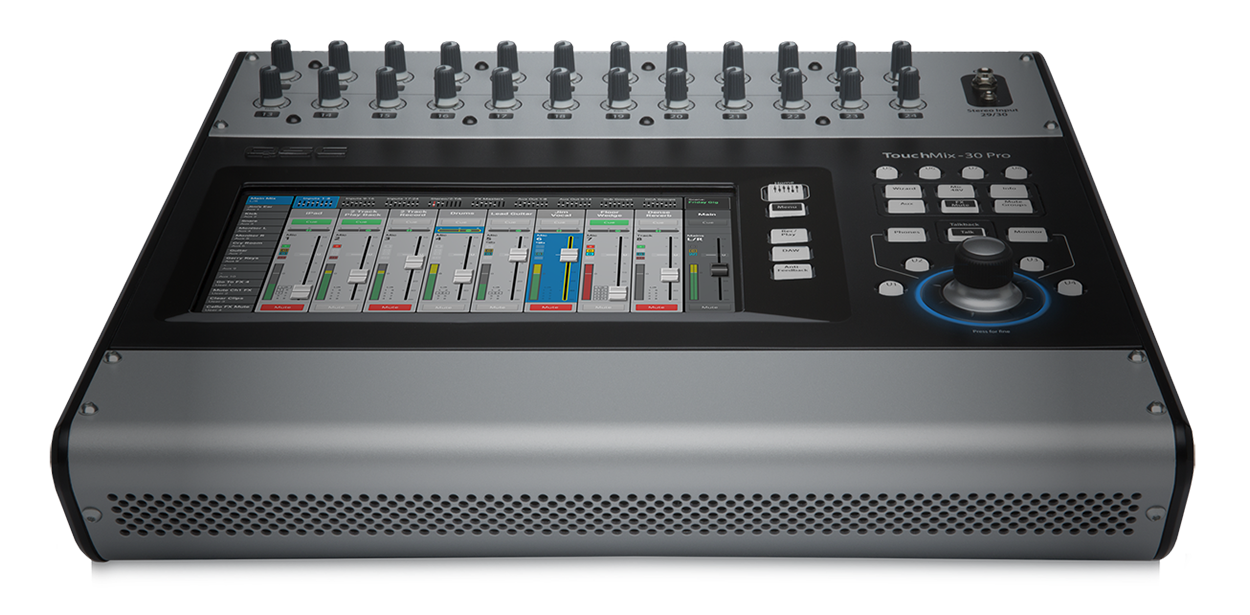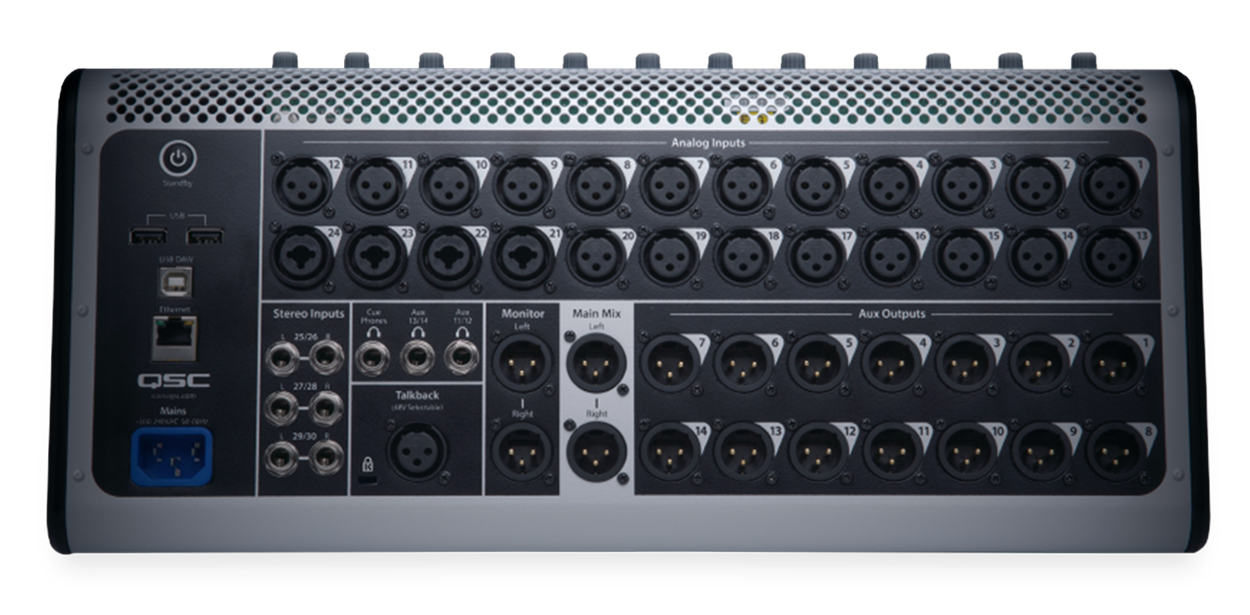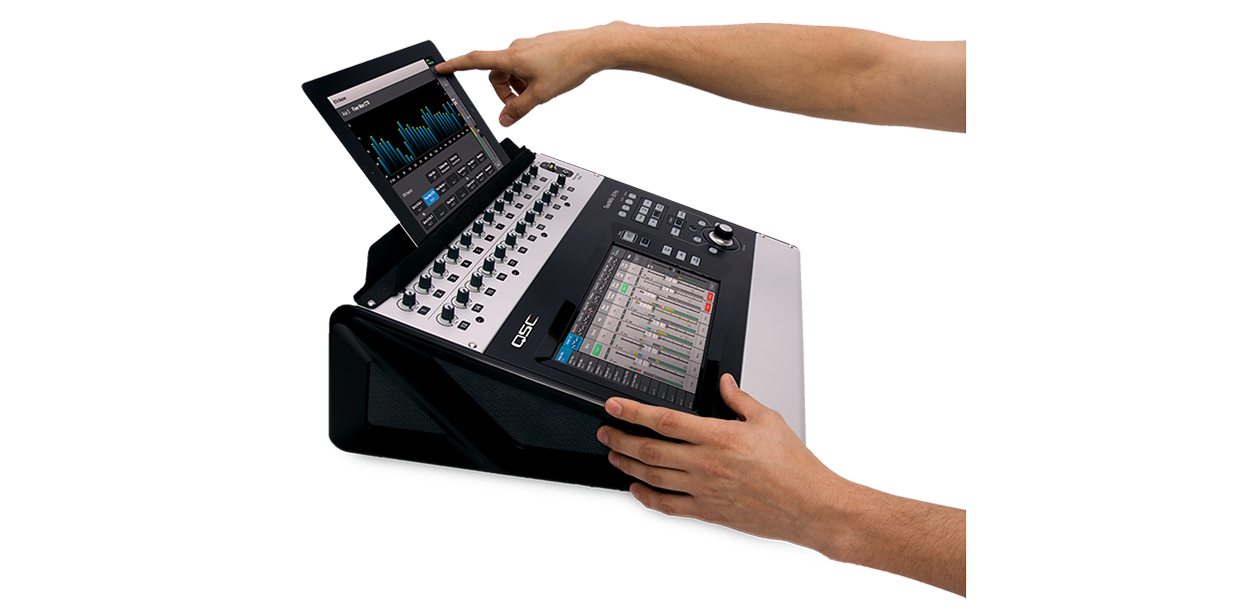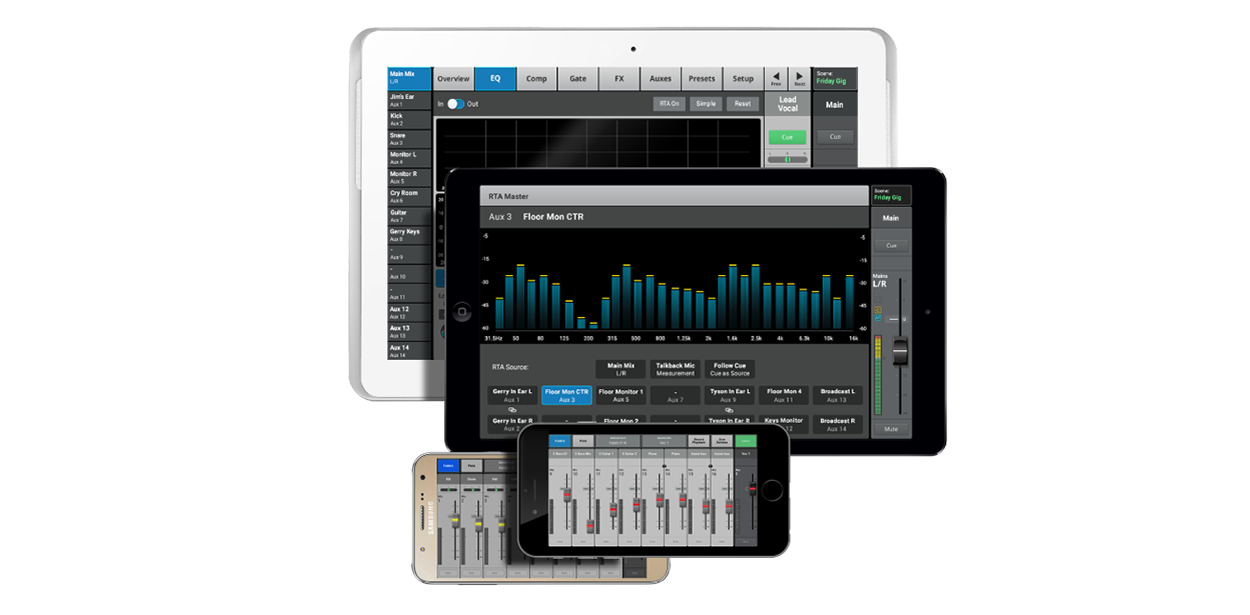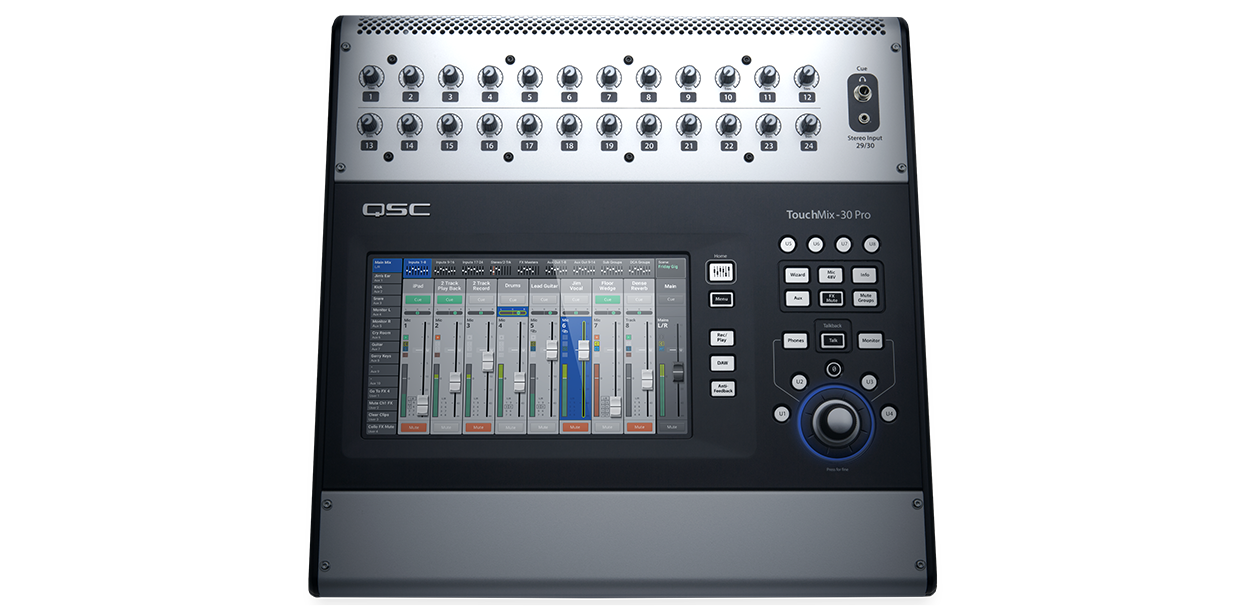

TouchMix®-30 Pro (Discontinued)
32-Channel Professional Digital Mixer

TouchMix® is quite simply the most powerful, compact mixer ever created. It offers the features, capabilities and sound quality of the world's most esteemed large format consoles in a highly compact and portable package that’s small enough to be carry-on luggage. Perfect for musicians, larger bands, AV production professionals and performance venues, the TouchMix-30 Pro goes "Beyond Mixing" by offering Wizards, Presets and other beneficial tools that help seasoned audio professionals and novices alike get great results quickly and easily.
Its 32 mixing channels (24 Mic/Line, 6 Line, Stereo USB) and 16 outputs offer tremendous signal management flexibility for a wide range of applications. Advanced features such as class-A microphone preamps, Anti-Feedback and Room Tuning Wizards, two real-time analyzers (RTA), patch matrix, 32-channel direct-to-external-drive recording and DAW interface with MacOS® and Windows® computers make it equally competent as both a professional live sound and a recording tool.
The touch-and-turn interface of TouchMix allows for tactile control over fader and mixer parameters while also providing a hardware connection to mixer functions. Mixer functions and displays are duplicated via iOS or Android devices over Wi-Fi, providing both portable, wireless connectivity as well as additional control surfaces of mixer functionality.
With firmware version 3.0, the TouchMix-30 Pro mixer now satisfy the needs of many more professionals with the addition of Scenes, Snapshots, Cue List management and offline editing functionalities. Scenes provide the user with the ability to store and recall the entire mixer configuration, while Snapshots allow the user to save and recall selected settings for designated channels without affecting other mixer settings. Cue Lists select and arrange Scenes, Snapshots and audio files into a predetermined sequence for recall during a show, while offline editing provides the user with the ability to create and edit mixer configurations without the mixer being connected to Wi-Fi. The v3.0 firmware release is also supported by an updated TouchMix Control app for iOS and Android™ devices, providing further enhancements to the remote control experience.
Key features include:
- Large (10-inch) multi-touch touchscreen offers a wealth of on-screen information while also providing confident hands-on control
- Anti-Feedback and Room Tuning Wizards simplify complex equalization tasks
- Two real-time analyzers (RTA) provide instantaneous display of channel tonal balance and room response
- Touch-and-route patch matrix provide easy “multing” and rearrangement of inputs
- 14 Aux mixes provide ample monitor configuration options
- Eight sub-groups with 6-band full parametric EQ, variable high- and low-pass filters and limiter may be linked for stereo
- A gain sharing Automatic Microphone Mixer is available for all 24 mic/line input channels
- 32-channel direct-to-hard drive record/playback — capture and recall performances without the need for an external computer
- 32-channel DAW interface with macOS® and Windows® computers allows for bidirectional I/O with popular workstation software
- MP3 playback direct from USB
- Download future upgrades directly from the Internet
Specifications
| TouchMix®-30 Pro | TouchMix®-16 | TouchMix®-8 | |
|---|---|---|---|
| Display | |||
| 254 mm (10 in) diagonal, 1024 x 600 pixel, color TFT, capacitive multi-touch sensing | 178 mm (7 in) diagonal color TFT, capacitive touch sensing | 178 mm (7 in) diagonal color TFT, capacitive touch sensing | |
| Inputs | |||
| Total | 32 (24 mic/line, 6 line, 2 stereo USB) | 22 | 14 |
| Mic/Line | 24 (20 XLR, 4 XLR combo) | 16 (12 XLR, 4 XLR combo) | 8 (4 XLR, 4 XLR combo) |
| Line | 6 (balanced, 1/4" TRS + top panel 1/8" (3.5 mm) stereo) | 2 Stereo (1/4" TRS) | 2 Stereo (1/4" TRS) |
| Stereo USB | Stereo USB / MP3 playback | Stereo USB / MP3 playback | Stereo USB / MP3 playback |
| Talkback | 1 (XLR with 48 V) | 1 (XLR) | N/A |
| Input Channel Processing | |||
| EQ | 4-band Parametric EQ with Hi/Low Shelving option, variable 24 db/octave HPF and LPF | 4-band Parametric EQ with Hi/Low Shelving option, variable 24 db/octave HPF and LPF | 4-band Parametric EQ with Hi/Low Shelving option, variable 24 db/octave HPF and LPF |
| Dynamics | Gate, Compressor | Gate, Compressor | Gate, Compressor |
| Delay | Delay (100 msec max) | Delay (100 msec max) | Delay (100 msec max) |
| Automatic Microphone Mixer | Gain Sharing, 24 channels, two instances (requires firmware 1.3 or higher) | N/A | N/A |
| Outputs | |||
| Total | 16 | 12 | 6 |
| Main L/R | 2 (XLR, line-level) | 2 (XLR, line-level) | 2 (XLR, line-level) |
| Aux | 14 (XLR, line-level) | 6 (XLR, line-level) + 2 (TRS, stereo In Ear Monitor or mono balanced line-level) | 4 (XLR, line-level) |
| In-ear Monitor (Stereo) | 2 (TRS, 16 ohm min. impedance, from Auxes 11/12 and 13/14) | 2 (TRS, 16 ohm min. impedance, from Auxes 7/8 and 9/10) | 1 (TRS, 16 ohm min. impedance, from Auxes 3/4) |
| Cue | 2 (Stereo, TRS, line or headphone, 16 ohm min. impedance) | 1 (Stereo, TRS, line or headphone, 16 ohm min. impedance) | 1 (Stereo, TRS, line or headphone, 16 ohm min. impedance) |
| Monitor L/R | 2 (Stereo, XLR) | 1 (Stereo, TRS, line or headphone, 16 ohm min. impedance) | N/A |
| Output Channel Processing | |||
| EQ | 1/3 octave GEQ, 6-band Parametric EQ, Variable High- and Low-Pass Filters | 1/3 octave GEQ, 6-band Parametric EQ, Variable High- and Low-Pass Filters | 1/3 octave GEQ, 6-band Parametric EQ, Variable High- and Low-Pass Filters |
| Anti-Feedback Filters | 12-band Anti-Feedback Filters | 8-band Anti-Feedback Filters | 8-band Anti-Feedback Filters |
| Dynamics | Compressor / Limiter | Limiter | Limiter |
| Delay | 100 msec | 100 msec | 100 msec |
| Recording / Playback1 | |||
| Multi-Track | 32 × 32 tracks direct to hard drive | 22 × 22 tracks direct to hard drive | 14 × 14 tracks direct to hard drive |
| DAW | 32 × 32 tracks Interface for macOS® (Core Audio) and Windows® computers | N/A | N/A |
| MP3 | Stereo USB / MP3 playback | Stereo USB / MP3 playback | Stereo USB / MP3 playback |
| Groups | |||
| DCA | 8 (with Mutes) | 8 (with Mutes) | 8 (with Mutes) |
| Mutes | 8 | 8 | 8 |
| Sub Groups | 8 (with 6-band Parametric EQ with High- and Low-Pass Filters, Limiter) | N/A | N/A |
| Cue | |||
| Selectable. AFL, PFL, Solo in Place | Selectable. AFL, PFL | Selectable. AFL, PFL | |
| Effects | |||
| 6 simultaneous, professional effects engines including Reverb, Echo, Delay, Chorus, Pitch Shift | 4 simultaneous, professional effects engines including Reverb, Echo, Delay, Chorus, Pitch Shift | 4 simultaneous, professional effects engines including Reverb, Echo, Delay, Chorus, Pitch Shift | |
| 1 Pitch Correct (assignable to any mono input channel) | 1 Pitch Correct (assignable to any mono input channel) | 1 Pitch Correct (assignable to any mono input channel) | |
| Real Time Analyzer (RTA) | |||
| 2 (1/3 octave, assignable to channels or user selectable source) | 1 (1/3 octave. Assignable to channels or user selectable source) | 1 (1/3 octave. Assignable to channels or user selectable source) |
| Preset Memory | |||
| 99 User Scenes, 120 Factory Presets, 99 User Presets | 99 User Scenes, 120 Factory Presets, 99 User Presets | 99 User Scenes, 120 Factory Presets, 99 User Presets |
| Digital Connections | |||
| 2 USB A connector, 1 USB B connector, 1 RJ-45 (connection for Wi-Fi router) | 2 USB A connectors | 2 USB A connectors | |
| External Control2 | |||
| TouchMix-30 Control App for iOS®/Android™ (via Wi-Fi). Third party control surfaces (via mixer or iOS® tablet) | TouchMix-8/16 Control App for iOS® and Android devices controls all mixer functions via Wi-Fi. | TouchMix-8/16 Control App for iOS® and Android devices controls all mixer functions via Wi-Fi. | |
| Wi-Fi3 | |||
| Requires external ethernet Wi-Fi router (recommended) or USB Wi-Fi adaptor 3 (not included) | USB Wi-Fi adaptor (included) or external Wi-Fi router (requires USB to ethernet adaptor) | USB Wi-Fi adaptor (included) or external Wi-Fi router (requires USB to ethernet adaptor) |
| Dimensions (H×W×D) | |||
| Shipping Container | 580 × 290 × 485 mm 22.8 × 11.4 × 19 in | 620 × 380 × 120 mm 24.4 × 15 × 4.7 in | 510 × 420 × 114 mm 20 × 16.5 × 4.5 in |
| Mixer only | 190 × 429 × 460 mm 7.5 in × 16.9 in × 18.1 in | 58 × 360 × 291 mm 2.3 in × 14.2 in × 11.5 in | 56 × 333 × 245 mm 2.2 in × 13.1 in × 9.6 in |
| Weight | |||
| Shipping | 11.2 kg / 24.7 lb | 5.2 kg / 11.5 lb | 4.8 kg / 10.6 lb |
| Mixer only | 7.9 kg / 17.5 lb | 2.98 kg / 5.9 lb | 1.95 kg / 4.3 lb |
| Power Requirements | |||
| 85 W, 100-240 VAC, 50-60 Hz | 42 W, 100 - 240 VAC, 50 - 60 Hz | 42 W, 100 - 240 VAC, 50 - 60 Hz | |
| Sampling Frequency | |||
| Selectable 44.1 kHz or 48 kHz | Selectable 44.1 kHz or 48 kHz | Selectable 44.1 kHz or 48 kHz | |
| Internal Processing | |||
| 32-bit floating point | 32-bit floating point | 32-bit floating point |
| THD | |||
| <0.005%, +4 dBu; 20 Hz-20 kHz, unity gain, any input to any output | <0.005%, +4 dBu; 20 Hz-20 kHz, unity gain, any input to any output | <0.005%, +4 dBu; 20 Hz-20 kHz, unity gain, any input to any output |
| Frequency Response | |||
| 20 Hz-20 kHz +/-0.5 dB, any input to any output | 20 Hz-20 kHz +/-0.5 dB, any input to any output | 20 Hz-20 kHz +/-0.5 dB, any input to any output | |
| Dynamic Range | |||
| 105 dB | 105 dB | 105 dB | |
| Equivalent input Noise | |||
| -126 dBu | -126 dBu | -126 dBu | |
| Residual Output Noise | |||
| -86 dBu | -86 dBu | -86 dBu | |
| Crosstalk | |||
| -80 dB | -80 dB | -80 dB | |
| S/N Ratio | |||
| -94 dB | -94 dB | -94 dB | |
| Gain (Mic Inputs) | |||
| 75 dB (60 dB analog, 15 dB digital) | 75 dB (60 dB analog, 15 dB digital) | 75 dB (60 dB analog, 15 dB digital) | |
| Maximum input Level | |||
| +16 dB (XLR mic/line inputs), +26 dB ( TRS mic/line inputs), +24 dBu (TRS line inputs), 0 dBv (top panel 1/8" stereo input) | +16 dBu (Mic/Line inputs, XLR), +26 dBu (Mic/Line inputs, TRS), +22 dBu (Stereo inputs) | +16 dBu (Mic/Line inputs, XLR), +26 dBu (Mic/Line inputs, TRS), +22 dBu (Stereo inputs) | |
| Maximum Output Level | |||
| +22 dBu (all line-level outputs) | +22 dBu (all line-level outputs) | +22 dBu (all line-level outputs) | |
| Phantom Power | |||
| 48 v, mic and talkback inputs, individually switchable | 48 v, all mic inputs, individually switchable | 48 v, all mic inputs, individually switchable | |
| Included Accessories | |||
| Power cable | USB Wi-Fi adapter, soft carrying case, power supply | USB Wi-Fi adapter, soft carrying case, power supply | |
| Optional Accessories | |||
| TouchMix-30 Pro Cover (Dust cover) TouchMix-30 Pro Tote (Soft, padded tote) TMR-2 (Rack mount kit) TS-1 (Tablet support stand) | TMR-1 (Rack kit) | TMR-1 (Rack kit) | |
| Battery Chemistry | |||
| Lithium Carbon Monofluoride | |||
| Regulatory Approvals | |||
| UL, CE, FCC (Class B), RoHS | NRTL-Approved, CE, FCC (Class B), RoHS | NRTL-Approved, CE, FCC (Class B), RoHS | |
1 A list of drives that have been validated by QSC may be found at qsc.com. The hard drive market is continuously changing. There are many drives QSC has not validated that are compatible with TouchMix multi-track recording. Always test external drives for compatibility before using. Minimum requirement is USB 3.0 SSD (recommended) or minimum 7800 RPM hard-drive , FAT32 format.
2 The TouchMix Personal Monitor App requires iOS 8 or higher.
3 TouchMix mixers do not support off the shelf USB Wi-Fi adaptors. Only QSC part number CP-000033-00 is supported.
All specifications are subject to change without notice.
Due to unprecedented demand, this product may currently be out of stock at some retailers. We continue to replenish supply regularly and are working to fulfill all orders as rapidly as possible. Please check with your dealer for the latest delivery updates.
Register your QSC Product
- Earlier access to Customer Support
- Product Updates via Email
- 6-Year Warranty Extension
